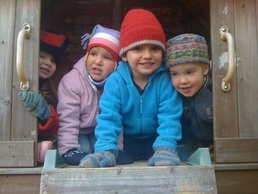Conflict Resolution

Young children are still developing the social skills that enable them to play cooperatively with other children and to function as part of a group. Often when children “misbehave”, it is because they haven’t yet learned the skills to negotiate, to ask for what they need, or to join in play with others, without grabbing, pushing, or hitting. Children are still learning cause and effect regarding how their behavior might impact others.
The High/Scope program offers an effective six step approach that I find to be effective in most cases:
1. Approach calmly, stopping any hurtful actions or language--A calm manner
reassures children that things are under control and can be worked out to everyone’s satisfaction.
2. Acknowledge feelings--Children need to express their feelings before they can let go of them and think about possible solutions to the problem.
3. Gather information--Adults are careful not to make assumptions or takes sides. We ask open-ended questions to help children describe what happened in their own words.
4. Restate the problem--Using the information provided by the children, the adult restates the problem, using clear and simple terms and, if necessary, rephrasing hurtful words.
5. Ask for ideas for solutions and choose one together--Adults encourage children to suggest solutions, helping to put them in practical and concrete terms. We accept their ideas, rather than impose our own, thus giving children the satisfaction of having solved the problem.
6. Give follow-up support as needed--Adults help children begin to carry out their solution, making sure that no one remains upset. If necessary, we repeat one or more steps until all the children return to their play.
The High/Scope program offers an effective six step approach that I find to be effective in most cases:
1. Approach calmly, stopping any hurtful actions or language--A calm manner
reassures children that things are under control and can be worked out to everyone’s satisfaction.
2. Acknowledge feelings--Children need to express their feelings before they can let go of them and think about possible solutions to the problem.
3. Gather information--Adults are careful not to make assumptions or takes sides. We ask open-ended questions to help children describe what happened in their own words.
4. Restate the problem--Using the information provided by the children, the adult restates the problem, using clear and simple terms and, if necessary, rephrasing hurtful words.
5. Ask for ideas for solutions and choose one together--Adults encourage children to suggest solutions, helping to put them in practical and concrete terms. We accept their ideas, rather than impose our own, thus giving children the satisfaction of having solved the problem.
6. Give follow-up support as needed--Adults help children begin to carry out their solution, making sure that no one remains upset. If necessary, we repeat one or more steps until all the children return to their play.
